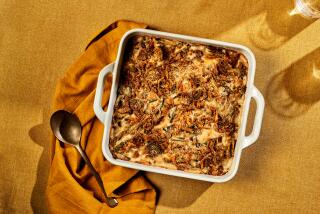40 Years Later
- Share via
It’s 10 p.m. I have a pot of beans on the stove I’m cooking your way for the first time (“Spilling the Beans,” Feb. 24), and I thank you. I’ve been a bean lover for over 40 years now, and I’m so pleased to know they’ll taste even better. And thank you for the addresses of the specialty bean farms.
MIKE VARADY
Los Angeles
*
When I first pulled out the Food section, I was really excited to see that beans were featured. Beans are one of my favorite foods, so I am always glad to find a recipe for them. While the cooking tips you offered were revelatory, the recipes were unappealing. There was only one reason for their lack of appeal: Almost every recipe contained pork of some form. Only one recipe in the entire section did not include pork, but that one was unrelated to your article. I do not know one person under 60 who eats pork.
STEPHANIE ASCH
Los Angeles
*
Splendid article on the bean-soaking question. I have been cooking beans without soaking for years, ever since I observed how the Mexicans (and Diana Kennedy) did it--though I go along with the mystique of the ceramic bean pot and wooden spoon.
I missed one vital piece of intelligence in your article, though: Where to get epazote. I have been using that herb so long that, like Kennedy, I find it unthinkable to cook black beans without it.
If anyone can turn up sources of supply, fresh or dried, bringing this remarkable flavor to public attention would be a service to California cuisine. Try it with your next pot of black beans and I think you will agree.
WALTER HOUK
Woodland Hills
*
We have been cooking with cannellini beans, ceci and lentils for the last 60 years. We have not soaked any beans for the last 40 years. This is the way we cook our beans: Rinse beans under cold water, put one pound beans in six-quart stainless-steel pot with cold water filled to the top, put on burner on high until it boils, then simmer with cover open about one inch. Add salt and pepper, one chopped onion, three cloves of garlic, chopped and 1/2 teaspoon Italian spices. Every 15 minutes stir the beans with a wooden spoon or plastic--never with a metal spoon. In the meantime, cook one large head of escarole. When it’s cooked, drain and save the water from the escarole; this is to add to the beans as their water cooks down. Put escarole on side. After 1 1/2 hours of cooking beans, chop four pieces of celery (with leaves, if possible) and add to beans. Continue cooking until beans are soft. Always make sure you keep the pot full of broth.
Now, in saucepan put two tablespoons of olive oil, two to three cloves of chopped garlic and saute until a light tan. Add the escarole and some broth and stir to heat through. Put escarole in a serving dish and top with beans, grated Romano or Parmigiano cheese and hot pepper (optional).
MARTIN STALLONE
Westlake Village
More to Read
Eat your way across L.A.
Get our weekly Tasting Notes newsletter for reviews, news and more.
You may occasionally receive promotional content from the Los Angeles Times.









